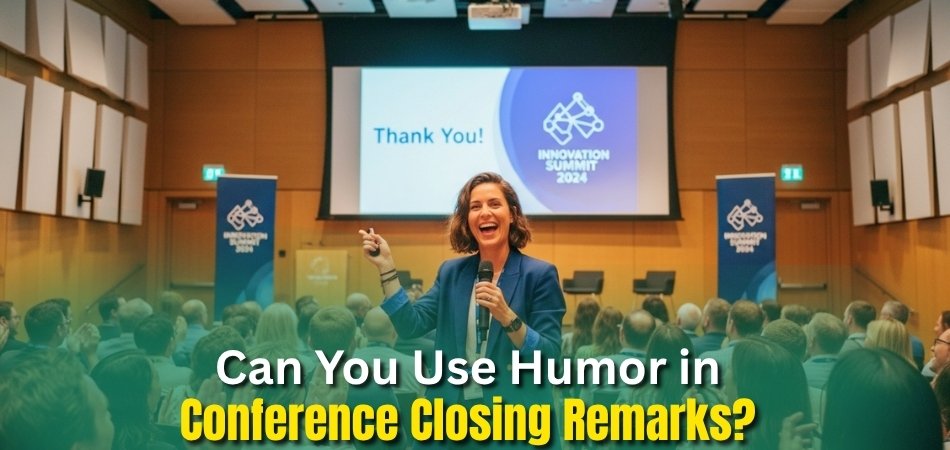Every great conference deserves a memorable ending, and sometimes a little laughter can make that happen. Humor can turn a formal moment into something warm, relatable, and unforgettable. It breaks the monotony, lightens the mood, and helps speakers connect with their audience on a more personal level.
So, can you use humor in conference closing remarks? Yes, absolutely, but with care and intention. The right kind of humor not only keeps people engaged but also leaves a lasting impression. When used appropriately, it shows confidence, creativity, and emotional intelligence, giving your message the perfect finishing touch.
However, humor isn’t a one-size-fits-all approach. Understanding your audience and choosing the right tone are key to making it work. Ready to learn how to make your closing remarks both professional and engaging? Keep reading to discover the art of using humor the right way.
Can You Use Humor in Conference Closing Remarks?
Humor can absolutely be used in conference closing remarks if done thoughtfully. A touch of wit helps the speaker connect with the audience, end the event on a cheerful note, and make the final message memorable. Whether it’s a small seminar or a large conference in USA, Canada, or elsewhere, humor can make one feel more human and heartfelt.
However, humor can also backfire in overly formal or sensitive contexts. A misplaced joke may shift attention away from the event’s purpose or make the audience uneasy. The key lies in judgment, knowing when humor enhances the speech and when it might distract. Always assess the mood, formality, and audience diversity before using it. Let’s explore a few smart ways to include humor naturally and respectfully in your closing remarks.
Storytelling for Light-Hearted Impact
A short, relevant story with a gentle twist can make people smile while reinforcing your main message. Share an experience related to the conference theme or your journey during the event. Keep it concise, real, and purposeful so the story feels meaningful rather than staged or overly rehearsed.
Callback Humor to Earlier Moments
Referring back to funny or memorable moments from the conference creates a shared sense of connection. It could be a humorous technical error, a witty comment by a speaker, or an audience reaction. This type of humor works well because it feels spontaneous and personal to the event.
Gentle Self-Irony
Lightly poking fun at yourself can make you appear relatable and humble. Mention something small, like stumbling over your notes or being grateful for coffee between sessions. Self-irony works best when it’s sincere and brief, adding charm without making your speech sound overly casual or scripted.
Appreciative Humor
End your remarks with humor blended with gratitude. You might thank the audience for “surviving a full day of PowerPoint slides” or appreciate the organizers for “making sure the Wi-Fi worked better than our sleep schedule.” It softens the tone while showing genuine appreciation.
When used with care, humor can turn a formal farewell into an uplifting experience. Keep it clean, inclusive, and authentic. If in doubt, test your lines beforehand.
Example one-liner you can include:
“Before we close, I’d like to thank our tech team; they made sure none of us had to pretend to understand the Wi-Fi password!”
How Humor Enhances Connection and Memorability?
Humor plays a powerful role in transforming closing remarks from a simple summary into an engaging experience. It lightens the atmosphere, helps the audience unwind, and leaves a lasting positive impression. When laughter is shared, it becomes a moment of unity. Let’s explore how humor strengthens the connection between speakers and audiences.
Builds Emotional Connection
Laughter bridges gaps between speakers and listeners. When the audience laughs together, it feels like a shared experience rather than a one-way speech. This connection breaks down formality and encourages genuine engagement. Humor makes the audience see the speaker as approachable, which enhances trust and attentiveness.
Improves Recall and Retention
People remember information better when it is presented with humor. A clever line or witty observation helps key points stand out long after the event ends. By combining humor with meaningful takeaways, you ensure your message resonates beyond the closing remarks, leaving both smiles and substance behind.
Relieves Stress and Fatigue
Conferences can be mentally exhausting, filled with presentations and discussions. Humor acts as a reset button, easing tension and refreshing the audience. A light laugh helps participants process the day’s insights with renewed energy, making the event’s conclusion feel positive rather than overwhelming.
Encourages Shared Positivity
When the audience laughs together, it creates a collective sense of joy and accomplishment. Shared laughter replaces end-of-event fatigue with optimism. This feeling strengthens bonds between attendees and organizers, ensuring that everyone leaves with pleasant memories and a positive impression of the overall experience.
Using humor in your closing remarks does more than entertain—it connects, relaxes, and helps audiences remember what truly mattered. A single lighthearted moment can turn a formal goodbye into a meaningful and memorable conclusion.
Subtle vs. Obvious Humor: Which Works Better for You?
Humor comes in many forms, but choosing the right type depends on the setting, audience, and tone of the event. In conference closing remarks, the distinction between subtle and obvious humor often determines how your message is received and defines the tone used for professional conference closing remarks. Now, let’s see how subtle and obvious humor differ in style, tone, and effectiveness for conference speakers.
Subtle Humor Feels Natural and Professional
Subtle humor relies on clever phrasing, relatable observations, or callbacks to earlier moments. It makes audiences smile rather than laugh loudly, keeping the tone balanced. This type works well for business or academic conferences where professionalism matters, but warmth and charm are still appreciated.
Obvious Humor Grabs Quick Attention
Obvious humor often comes in the form of direct jokes or punchlines. It can energize the audience quickly but may feel out of place if overused. This style fits informal gatherings or team-building events where people expect casual laughter and light-hearted fun.
Why Subtle Humor Works Best for Conferences
Most professional conferences benefit from humor that feels authentic and contextual. Subtle humor lets speakers connect through shared experiences, like long sessions or relatable struggles. It enhances attention and adds personality without risking awkwardness or misunderstanding. Obvious jokes, while fun, can sometimes feel forced in formal environments.
Example Comparison Template
| Type | Example | When to Use |
| Subtle | “I think our coffee breaks had the highest attendance rate today.” | Most professional events |
| Obvious | “Why did the keynote speaker cross the stage? To get to the next slide.” | Informal or team-building events |
Balancing humor is about matching tone and context. Subtle humor usually creates smoother engagement, while obvious humor suits relaxed settings. Choose the type that reflects your confidence and the audience’s expectations for the most effective closing remark.
Knowing Your Audience Before You Joke
Even the best humor can fall flat if it doesn’t match the audience’s background, expectations, or mood. Knowing who you are speaking to is essential before adding any funny lines to your closing remarks. Humor that resonates with one group might confuse or offend another, so awareness is key to getting it right.
Every audience is unique, shaped by factors like culture, age, and professional background. Understanding these details helps you adapt your humor naturally. Let’s explore how to recognize what works, what doesn’t, and how to tailor your delivery for the right effect.
Respect Cultural and Professional Diversity
What’s funny in one culture may not translate in another. For international or mixed audiences, stick to universally relatable topics like daily experiences or light conference humor. Avoid jokes that rely on slang, regional phrases, or stereotypes. Respecting diversity keeps your tone inclusive and professional.
Match Humor to Event Formality
A corporate summit, academic conference, or industry forum each has a different tone. Light observations fit well in formal settings, while playful humor suits creative or team events. Adjusting your style shows awareness and ensures your humor enhances rather than disrupts the atmosphere.
Observe Audience Reactions and Energy
Pay attention to your audience’s expressions, engagement, and response throughout the conference. If people seem serious or fatigued, a quick, gentle remark works better than a long joke. Reading the room helps you strike the right balance between confidence and sensitivity.
Test and Refine Your Humor in Advance
Before delivering your speech, share your jokes or lines with trusted peers. Their feedback helps you catch any unintended meanings or awkward phrasing. Rehearsing humor ensures your timing and tone feel natural, preventing uncomfortable pauses or mixed reactions during the event.
Understanding your audience is what separates confident humor from careless delivery. When you read the room, respect differences, and prepare thoughtfully, humor becomes a bridge that connects rather than divides.
Common Mistakes Speakers Make When Trying to Be Funny
Humor can make a closing speech memorable, but when misused, it can easily have the opposite effect. Many speakers try too hard to make their audience laugh, forgetting that humor should enhance the message, not dominate it. Understanding these common mistakes helps maintain professionalism while keeping the audience engaged and comfortable.
Overusing Humor or Forcing Laughter
Adding too many jokes can shift focus away from your message. Humor works best in moderation; forcing laughter makes you appear less confident and distracts the audience. Keep it simple; one or two light moments are enough to leave a lasting impression.
Using Inside Jokes or Personal References
Inside jokes only work if everyone understands them. Referencing something only a few people know isolates others and breaks the connection. Always choose humor that’s relatable to the entire audience rather than exclusive or context-specific.
Being Sarcastic or Insensitive
Sarcasm can easily be misinterpreted, especially in diverse audiences. Avoid jokes about religion, gender, or sensitive social topics. Even a small misstep here can overshadow your professionalism. Humor should unite people, not make them uncomfortable or defensive.
Losing Sight of the Speech’s Purpose
Humor should support your closing message, not replace it. Keep the focus on gratitude, reflection, and inspiration. If the humor feels disconnected from the conference’s theme, it can seem forced or out of place. Always make sure the joke serves your speech’s goal.
Do & Don’t Table for Using Humor
| Do | Don’t |
| Use light humor relevant to the topic | Mock audience or speakers |
| Keep it brief and natural | Over-explain the joke |
| Test your lines before delivery | Use humor on sensitive issues |
Good humor enhances a speaker’s credibility, while poor humor risks losing attention and respect. By avoiding common mistakes and staying considerate, you can use humor as a subtle, effective tool to connect with your audience and close your speech confidently.
Tips to Make Humor Sound Natural and Authentic
Great humor doesn’t come from perfect timing alone; it comes from being yourself. When humor sounds genuine, it builds trust and makes your message more memorable. To make humor flow naturally, focus on delivery and expression rather than memorized lines. Here are a few practical tips that can help you sound confident and relatable when adding humor to your speech.
- Practice Your Delivery: Rehearse your lines out loud multiple times. This helps you understand rhythm and timing while ensuring the humor feels conversational. Practicing also reduces hesitation and builds the confidence needed to sound spontaneous.
- Maintain Eye Contact: Make brief eye contact with your audience as you deliver a humorous line. It builds connections and lets you read reactions instantly. Audiences respond better when they feel included in the moment rather than being talked at.
- Smile Genuinely: A natural smile communicates warmth and sincerity. Even before your joke lands, it sets a friendly tone. Smiling shows that your humor is good-natured and encourages the audience to relax and respond positively.
- Use a Natural Speaking Tone: Avoid sounding overly rehearsed or theatrical. Speak as if you’re sharing a casual observation with friends. A steady and conversational tone makes humor blend effortlessly with the rest of your message.
- Pause Before the Punchline: A brief pause helps your audience anticipate the humor. It builds curiosity and ensures the punchline gets the attention it deserves. Avoid rushing; timing is what turns a simple sentence into a well-received laugh.
Authentic humor reflects who you are, not just what you say. With genuine expression and the right tone, even a simple joke can leave a lasting impression. Close your next conference confidently, and let your humor speak with honesty and ease, creating an impactful closing conference speech that your audience will remember.
Frequently Asked Questions
Humor in professional events often sparks curiosity. Many speakers wonder how to use it confidently without overdoing it or losing professionalism. Here are some commonly asked questions that can help you better understand how to apply humor effectively in your next conference closing speech.
How Can I Tell If My Joke Will Work Before the Event?
The best way is to test it on a few friends or colleagues and ask for honest feedback. If it makes them smile naturally, it’s likely to work. Always consider if your humor fits the audience and setting.
Is It Okay to Use Humor When I’m Not Naturally Funny?
Yes, you don’t need to be a comedian to use humor well. Focus on light, relatable moments instead of telling full jokes. Simple observations or kind laughter at yourself can make your tone friendly and genuine.
Can Humor Help If the Event Felt Too Serious?
Absolutely. A short, thoughtful joke can lighten the atmosphere and end things on a positive note. It helps the audience relax after heavy discussions and leaves them with a sense of warmth and connection.
Should I Use Visual Aids or Slides to Add Humor?
You can, but only if it feels natural to your style. A funny image or quote can support your words, but never rely solely on visuals. Keep it simple and ensure it doesn’t distract from your message.
What Should I Do If the Audience Doesn’t Laugh?
Stay calm and continue smoothly. Smile and move on as if it were intentional. Sometimes, audiences enjoy the humor quietly, so don’t panic. Your composure will keep the atmosphere comfortable and professional.
Can Humor Be Used to Thank the Organizers or Team?
Yes, it can make your appreciation more memorable. You can mix gratitude with a little wit, like joking about the team’s hard work or long hours. Just ensure the tone stays respectful and kind.
How Long Should a Humorous Part Last in My Closing Speech?
Keep it short, around 30 to 45 seconds is enough. The goal is to make people smile, not turn your closing into a comedy act. A brief, natural laugh works best to keep things meaningful and light.
Concluding Lines
Ending a conference is more than saying goodbye; it’s your final chance to leave a lasting impression. Adding a touch of humor can make that moment memorable, helping your words resonate and your audience walk away with genuine smiles.
So, can you use humor in conference closing remarks? Yes, when it feels appropriate and respectful. Humor works best when it connects with the audience’s experience and reinforces your main message. It turns a formal ending into a heartfelt conclusion filled with warmth and relatability.
The most impactful speakers know that humor, used wisely, builds connection and confidence. Keep it short, thoughtful, and natural. By closing with positivity and laughter, you’ll make your conference finale something people truly remember.








